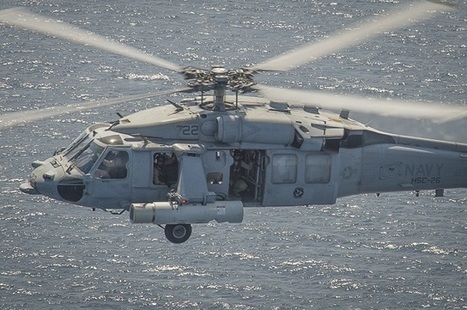WASHINGTON, 30 Dec. 2014. Ocean mine warfareexperts at the Northrop Grumman Corp. Aerospace Systems segment in Melbourne, Fla., will provide the U.S. Navy with a helicopter-based system designed to detect floating and submerged ocean mines with laser beams under terms of a potential $163.6 million contract announced last week.
Officials of the Naval Sea Systems Command in Washington awarded a $35.5 million contract to Northrop Grumman two days before Christmas to build and support the AN/AES-1 airborne laser mine detection systems (ALMDS).
The ALMDS electro-optical system will be mounted on Navy MH-60S helicopters based on the littoral combat ship (LCS). The laser-based mine-detection system uses streak tube imaging light detection and ranging (LIDAR) sensors to detect, classify, and localize surface and near-surface moored sea mines.
The ALMDS provides a revolutionary, high-area-coverage-rate capability that is organic to -expeditionary and carrier strike groups, Navy officials say. This contract includes options which, if exercised, would bring the cumulative value of this contract to $163.6 million.
The system, which will be part of the mine countermeasures (MCM) mission package aboard the new LCS, is designed for rapid wide-area reconnaissance and assessment of anti-ship mines in coastal waters, harbors, confined straits, choke points and amphibious assault areas where aircraft carriers and expeditionary strike groups must operate.
The ALMDS uses pulsed laser light and streak tube receivers housed in an external equipment pod on the MH-60 helicopter. These lasers are designed to search the water column from the surface to about 40 feet in depth -- the area where mines are the biggest threats and coincidentally where mine-hunting sonar systems are least effective. The system takes an image of the entire near-surface water column potentially containing mines.
The ALMDS projects a pulsed wide 538-nanometer blue-green laser beam into the water and samples at rates greater than 100 per second. ALMDS is capable of day or night operations without stopping to stream out or recover equipment and without towing any equipment in the water. It uses the forward motion of the aircraft to generate image data negating the requirement for complex scanning mechanisms.
The system is contained in a pod mechanically attached to the MH-60S with a standard Bomb Rack Unit 14 (BRU-14) mount and electrically via a primary and auxiliary umbilical cable to the operator console. Data is stored on a mass memory unit, and the ALMDS operator's console is common to all MH-60S airborne mine countermeasures systems.
The ALMDS was designed with VMETRO central electronics chassis (CEC) ---- liquid-cooled air transportable rack (ATR) systems with VMETRO CSW1 6U VXS (VITA 41) switch cards and VPF1 quad processor payload cards. The Curtiss-Wright Corp. Defense Solutions division in Santa Clarita, Calif., acquired VMETRO in 2008.
The CSW1 and VPF1 embedded computing boards process image sensor data using real-time multiprocessing over high-speed serial communications. The ALMDS CEC uses a combination of field-programmable gate arrays (FPGAs) and PowerPC processors.



 Your new post is loading...
Your new post is loading...








